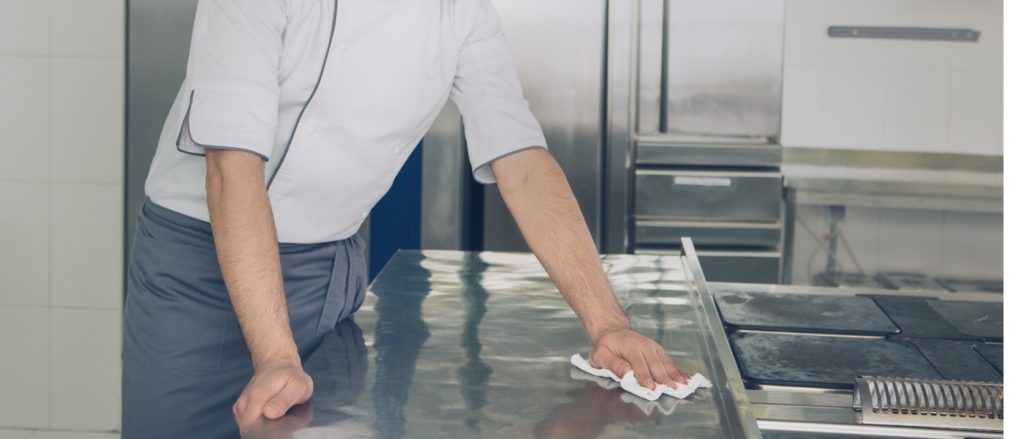
With the changing COVID-19-related guidelines from local and state authorities and federal organizations including the Centers for Disease Control and Prevention (CDC), now is a good time for restaurants of all types to reevaluate how they organize, clean, and sanitize their commercial kitchens. As the main engine of a restaurant operation, it is essential to keep the kitchen well maintained and running smoothly. Most importantly, having stringent and consistent cleaning and disinfecting procedures is a must for keeping employees and customers safe. Whether you are running a mom-and-pop bakery, a three-star gourmet restaurant, or a large industrial kitchen, there are fundamental procedures to follow that will keep your kitchen operating at its best.
Make a Plan and Check List

Organize Separate Workstations
Whether it’s chopping produce and preparing raw ingredients or cleaning dishes and utensils, every step in a kitchen’s processes should correspond with its own workstation. This separation facilitates better organization of the food preparation and the specific cleaning procedures that will help maintain sanitary practices and protect against cross-contamination.
- Prepping Area: Used for chopping, preparing, and marinating, this workstation is generally the first step in a kitchen’s process and where frequently used items are stored. It is important to keep all ingredients labeled and well organized at all times, with frequently used items in close reach. Since it is also often a multi-use area, keeping the area and all food prep equipment clean is critical to avoid cross-contamination. Countertops, prep tables, cutting boards, and utensils should be cleaned and disinfected throughout the day.
- Cooking Area: The grease, oils, debris, and carbon that are normal byproducts of cooking in the kitchen make it particularly important for keeping clean and sanitary. Fryers, grills, griddles, ovens, and ranges should be cleaned every day, and deep cleaned once a week. Grease can build up in a kitchen quickly, especially if it is not being cleaned on a regular basis. For easy and fast clean-up of greasy messes and buildup, products like degreasing multi-surface disposable wipes can facilitate the end-of-shift heavy-duty cleaning and grease removal.
- Refrigeration/Freezer: The refrigerator and freezer are likely the most-used appliances in a commercial kitchen and keeping them clean, organized and in working condition is essential to keeping food safe for consumption. Labeling all food, especially perishable and temperature-sensitive items, with food type, date of storage, and expiration date will help avoid cross-contamination, and cut down on waste. Perishable goods should also be easily accessible and organized in a way that promotes the first-in, first-out method. The interior and exterior of refrigerators and freezers should be cleaned regularly using soap and water or multi-surface cleaning products. A refrigerator, cooler, or freezer that is not properly maintained can lead to poor grades from health inspectors as well as undue strain, excessive energy consumption, and possible malfunction.
- Dishwashing/Cleaning Area: The bussing and dishwashing stations need to be as clean and organized as the rest of the kitchen. Customer dishes and utensils should be washed as soon as they come in and keep a separate area for drying dishes. Drains, sinks, faucets, wash stations, and floors need to be regularly cleaned and maintained. The cleaning supply storage area should also be well organized with stock and inventory updated, and instructions and processes posted.
Train and Reinforce Procedures
For most areas in the kitchen, there are three main steps to follow: cleaning the food contact surface of visual debris, rinsing the area with potable water, and finally, sanitizing the surface with multi-surface wipes. All staff in the kitchen need to be trained on the proper cleaning and disinfecting procedures and frequency, including knowing the specific instructions for each product used. Management should post signage detailing steps and protocols, and monitor and reinforce these on a regular basis.
Practice FIFO
Finally, every commercial kitchen should use the first-in, first-out (FIFO) method, an inventory management system that ensures the items you purchase or prepare first are also the items you sell or serve first. In a kitchen, this simply means utilizing all the oldest foods first so that they don’t spoil and go to waste. Properly labeled and organized food items will help kitchen staff know what food should be used and when expiration dates are approaching. Computerized inventory management systems can also help in tracking and organizing food usage, ordering, stocking, and budgeting.
Cleaning, sanitization, and organization have always been important elements in commercial food settings, regardless of type or size. Not only do these elements affect a restaurant or food establishment’s bottom line, but they are also crucial for food safety and maintaining the health of staff and customers.
Sources
- https://www.cdc.gov/coronavirus/2019-ncov/community/organizations/business-employers/bars-restaurants.html
- https://www1.nyc.gov/assets/doh/downloads/pdf/imm/covid-19-checklist-for-restaurants.pdf
- https://www.statefoodsafety.com/Resources/Resources/april-cartoon-first-in-first-out-fifo

